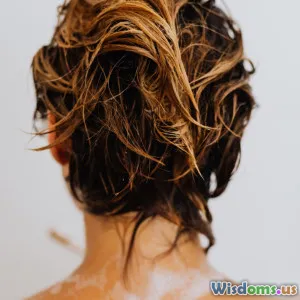
Why Does Hair Porosity Matter in Choosing the Right Products
8 min read Unlock the secret of hair porosity and learn to choose perfect hair products for healthier, shinier hair. (0 Reviews)
Why Does Hair Porosity Matter in Choosing the Right Products?
Our hair is more than just a cosmetic feature; it’s a living structure that communicates its needs through its texture, shine, and manageability. One fundamental factor that influences how hair behaves and responds to products is hair porosity—a sometimes overlooked but crucial aspect of hair care. By understanding your hair’s porosity, you can customize your hair care regimen, choosing products and techniques that truly nourish and protect.
What Is Hair Porosity?
Hair porosity refers to your hair’s ability to absorb and retain moisture. At a microscopic level, the hair cuticle—the outermost layer of the hair strand—can either lay flat or be raised, creating tiny gaps.
- Low porosity hair has tightly packed cuticles that resist moisture absorption but retain it well once hydrated.
- Medium (normal) porosity hair has a healthy cuticle layer that allows moisture in and traps it effectively.
- High porosity hair has damaged or raised cuticles that absorb moisture quickly but lose it just as fast.
Understanding this classification helps you tailor your hair care products, ensuring your hair remains moisturized, manageable, and vibrant.
Why Hair Porosity Is a Game-Changer in Product Selection
Product Absorption and Retention
Different hair porosities respond distinctly to moisture and oils:
- Low Porosity: Products, especially heavy creams and oils, tend to sit on the surface. Lightweight, water-based products or those with heat-activated ingredients work better here to open the tight cuticle and allow penetration.
- High Porosity: Hair absorbs products quickly but also loses moisture rapidly. Rich, sealing creams and oils like castor or coconut oil lock in hydration effectively.
- Medium Porosity: Most commercial hair products are formulated for this type, making your routine less complicated but still benefits from customizing for weather and styling needs.
Preventing Product Build-Up and Damage
Using mismatched products can cause buildup for low porosity hair or leave high porosity hair underprotected and dry. For instance, a study by the International Journal of Trichology highlights that low porosity hair is prone to residue due to its tightly bound cuticle, hence the need for clarifying shampoos or lighter formulations.
How to Determine Your Hair’s Porosity
Understanding your hair type starts with simple tests that anyone can perform at home:
The Float Test
Place a few clean strands in a bowl of water. Low porosity hair floats because it repels water, medium porosity sinks slowly, and high porosity sinks promptly due to moisture absorption.
The Slip 'n' Slide Test
Run your fingers along the hair shaft. Low porosity hair feels smooth, medium slightly textured, and high porosity hair feels rough due to raised cuticles.
Observing Drying Time and Product Reactions
If your hair takes forever to dry or repels products, it’s likely low porosity. If it dries quickly and responds badly to hot tools, your hair could be high porosity.
Matching Hair Products to Porosity Levels
Low Porosity Hair
People with low porosity hair benefit from:
- Lightweight, water-based moisturizers
- Heat-activated deep conditioners to gently open the cuticles
- Avoid heavy oils and butters that cling to strands
Example: Camellia oil is lighter and absorbs better for low porosity hair compared to heavy jojoba or castor oils.
Medium Porosity Hair
Versatile and balanced, maintain your hair with:
- Standard moisturizing shampoos and conditioners
- Protein treatments intermittently to preserve strength
Example: Shea Moisture’s Raw Shea Butter Restorative Conditioner is broadly suitable.
High Porosity Hair
Need intense moisture sealing and cuticle repair:
- Rich creams and oils to lock moisture
- Leave-in conditioners with protein to patch cuticle gaps
- Avoid sulfates and harsh chemicals that strip oils further
Example: Products containing hydrolyzed proteins and castor oil help seal damaged strands.
Real-World Insights: Celebrities and Experts on Hair Porosity
Many hairstylists emphasize the importance of porosity for healthy hair. Renowned stylist Jen Atkins says, “Hair porosity is the blueprint for mentalizing hair’s needs. Skipping this results in wasted products and disappointing outcomes.” Celebrities like Tracee Ellis Ross have voiced their education on porosity helping them switch to more customized product lines that restored their natural curl vitality.
Beyond Products: Daily Habits for Managing Porosity
Proper porosity management goes beyond choosing shampoos or conditioners:
- Use warm water for washing low porosity hair to open cuticles.
- Apply cool water rinses to seal cuticles in medium porosity hair.
- For high porosity hair, limit heat styling and protect strands with serums enriched with antioxidants or ceramides.
Conclusion: Empower Your Hair Care by Knowing Porosity
Hair porosity is foundational to understanding and loving your hair. The science behind moisture absorption and retention clarifies why certain products and techniques work for you and others don’t. By identifying your hair’s porosity, you unlock the secret to selecting products that nurture, protect, and elevate your natural beauty.
Instead of random experimentation, give your hair the personalized care it deserves. With the right knowledge and products, healthier, shinier, and more resilient hair is within reach—because good hair days start with awareness.
Remember: Porosity can change with chemical treatments, climate, and styling, so reassess your hair regularly and adapt your routine accordingly.
References
- International Journal of Trichology, "Hair Porosity and Its Impact on Hair Care" 2020.
- Interviews with Jen Atkins, celebrity hairstylist.
- Tracee Ellis Ross on natural hair care in interviews and Haircare blogs.
Rate the Post
User Reviews
Other posts in Health & Wellness
Popular Posts















